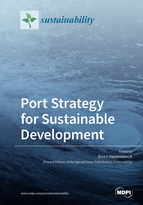Port Strategy for Sustainable Development
A special issue of Sustainability (ISSN 2071-1050). This special issue belongs to the section "Sustainable Transportation".
Deadline for manuscript submissions: closed (30 September 2020) | Viewed by 47893
Special Issue Editor
2. Faculty of Business Economics, Universiteit Antwerpen (UA), 2000 Antwerp, Belgium
Interests: port strategy; cluster competitiveness; corporate and cluster shared value, sustainability and the circular economy; project evaluation; infrastructure and transport
Special Issue Information
Dear Colleagues,
Today, most large port hubs include the circular economy transformation challenge, together with smart digitalization and Internet of Things (IoT), in their strategic priorities. Some port authorities even express the ambition for their port to become a maritime circular hotspot. However, many ports do not seem to have progressed beyond incremental, small-scale sustainable innovations, or the support of rather fragmented sustainability initiatives.More research can help ports to understand what takes them to the next level in terms of sustainable strategy, preparing for or implementing sustainable and circular business. However, what really takes ports to the next level in terms of preparing for and implementing circular business has hardly been addressed in research so far. Challenges are complex, since ports do not only have to reconsider their own core activities but also their role in the supply chain of shippers, to lift themselves out of the linear lock-in. Opportunities are also created, as Fusco Girard (2013) argued: “Economic circuits are shortened and the local economy is strengthened through integration” (Fusco Girard, L., 2013, Toward a smart sustainable development of port cities/areas: The role of the “Historic Urban Landscape” approach. Sustainability, 5(10), 4329-4348.). This author put forward that a port’s circularization process consists of an industrial, urban, and city-territorial or regional symbiosis (Fusco Girard, 2013). However, non-business (government, cluster organizations, etc.) initiatives or support are often behind circular pilot projects, and as much as it can serve as an engine for innovation towards sustainable port development, port authorities and businesses finally need to embrace circular learning and turn these projects into sustainable business models, i.e., with the design of the value creation, delivery, and capture mechanisms employed (Teece, 2010). This strategic change or refocus requires new insights into innovative governance and business frameworks, the link between strategy and commercially viable business models, systems innovation, intensified stakeholder collaboration and co-creation, altered traffic segments and hinterland focus, etc.
Therefore, for this Special Issue in Sustainability, I am calling for papers on research into new sustainable strategies and sustainable or circular (business) models for ports. Theoretical as well as empirical, and quantitative as well as qualitative contributions are welcomed. Ultimately, proposed papers for this Special Issue may cover a broad range of strategies and policies, as long as the focus is on supporting ports towards their sustainable and/or circular transition.
Prof. Dr. Elvira Haezendonck
Guest Editor
Manuscript Submission Information
Manuscripts should be submitted online at www.mdpi.com by registering and logging in to this website. Once you are registered, click here to go to the submission form. Manuscripts can be submitted until the deadline. All submissions that pass pre-check are peer-reviewed. Accepted papers will be published continuously in the journal (as soon as accepted) and will be listed together on the special issue website. Research articles, review articles as well as short communications are invited. For planned papers, a title and short abstract (about 100 words) can be sent to the Editorial Office for announcement on this website.
Submitted manuscripts should not have been published previously, nor be under consideration for publication elsewhere (except conference proceedings papers). All manuscripts are thoroughly refereed through a single-blind peer-review process. A guide for authors and other relevant information for submission of manuscripts is available on the Instructions for Authors page. Sustainability is an international peer-reviewed open access semimonthly journal published by MDPI.
Please visit the Instructions for Authors page before submitting a manuscript. The Article Processing Charge (APC) for publication in this open access journal is 2400 CHF (Swiss Francs). Submitted papers should be well formatted and use good English. Authors may use MDPI's English editing service prior to publication or during author revisions.
Keywords
- Port strategy
- Circular economy
- Sustainability
- Port policy
- Strategic change
- Circular (business) models






